Analyzing Myer Australia's Inventory and Operation Management
VerifiedAdded on 2023/03/23
|11
|2685
|99
Report
AI Summary
This report provides an overview of Myer Australia's inventory and operation management strategies, focusing on the company's inventory systems, supply chain processes, and overall operational effectiveness. It highlights Myer's use of RFID technology for inventory tracking, different types of inventory utilized (finished goods, transit, buffer, and anticipation), and the implications of their OM strategy on omnichannel capabilities and supply chain efficiencies. The analysis covers Myer's inventory management techniques, including a personalized inventory control method, and assesses the effectiveness of the implemented RFID technology in reducing labor costs and improving inventory accuracy. Furthermore, the report examines Myer's supply chain systems, the role of stakeholders such as suppliers, merchandisers, and customers, and the impact of changing social trends and online business growth on the company's operations. Finally, the report concludes with recommendations for Myer to develop new marketing strategies, adopt competitive pricing, and focus on digital marketing to enhance customer experience and expand its market reach. Desklib offers a variety of solved assignments and past papers for students.
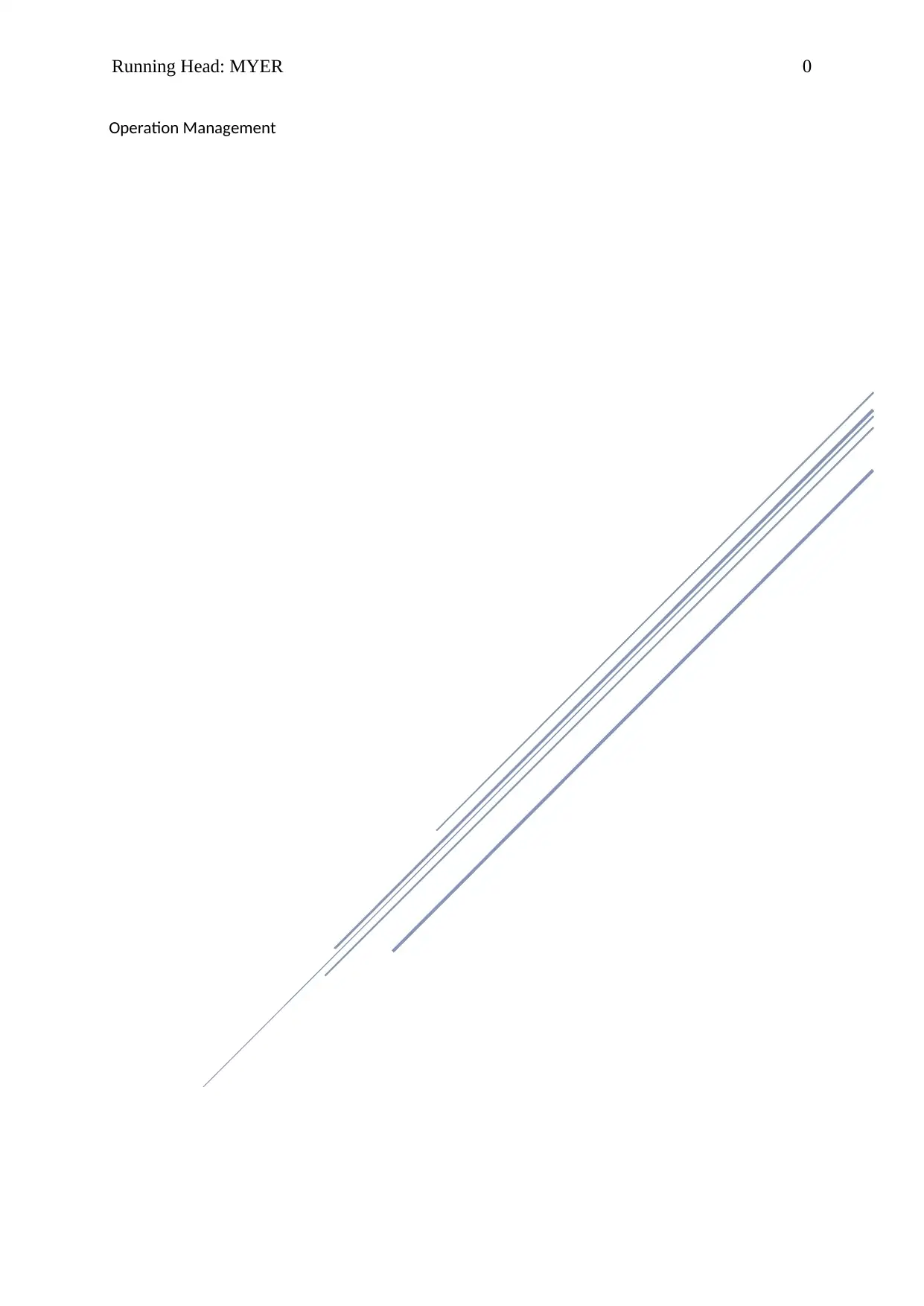
Running Head: MYER 0
Operation Management
Operation Management
Paraphrase This Document
Need a fresh take? Get an instant paraphrase of this document with our AI Paraphraser
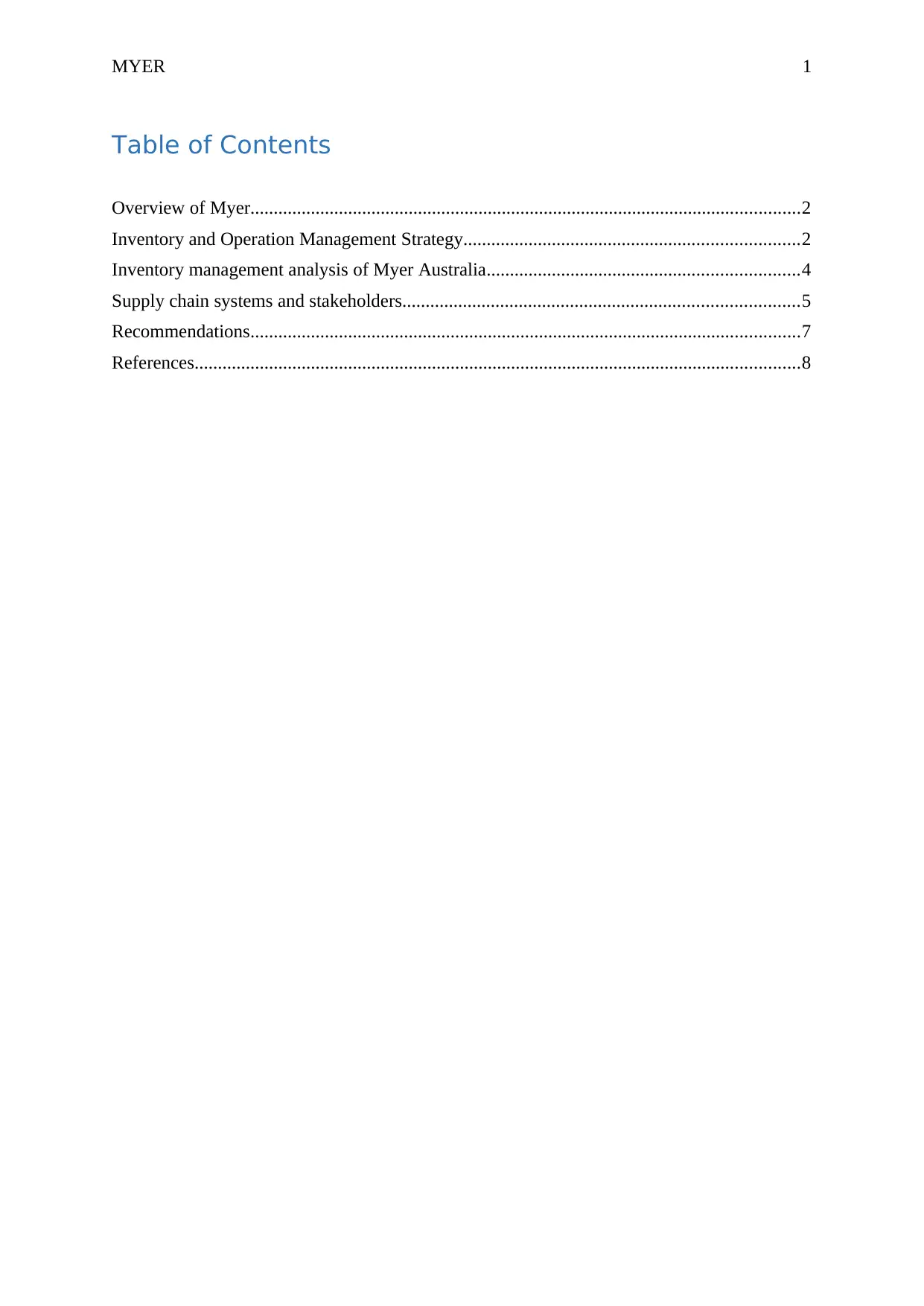
MYER 1
Table of Contents
Overview of Myer......................................................................................................................2
Inventory and Operation Management Strategy........................................................................2
Inventory management analysis of Myer Australia...................................................................4
Supply chain systems and stakeholders.....................................................................................5
Recommendations......................................................................................................................7
References..................................................................................................................................8
Table of Contents
Overview of Myer......................................................................................................................2
Inventory and Operation Management Strategy........................................................................2
Inventory management analysis of Myer Australia...................................................................4
Supply chain systems and stakeholders.....................................................................................5
Recommendations......................................................................................................................7
References..................................................................................................................................8
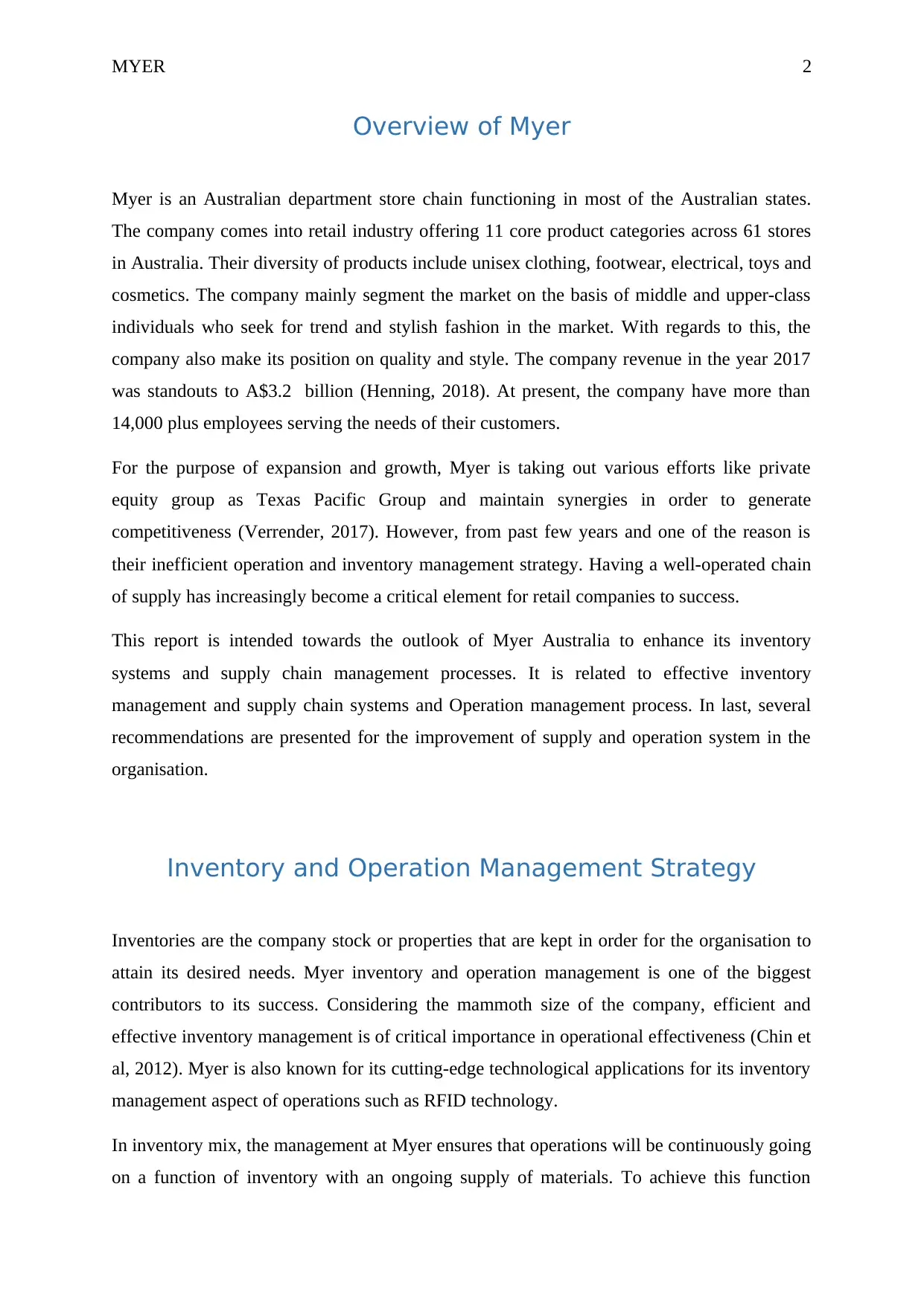
MYER 2
Overview of Myer
Myer is an Australian department store chain functioning in most of the Australian states.
The company comes into retail industry offering 11 core product categories across 61 stores
in Australia. Their diversity of products include unisex clothing, footwear, electrical, toys and
cosmetics. The company mainly segment the market on the basis of middle and upper-class
individuals who seek for trend and stylish fashion in the market. With regards to this, the
company also make its position on quality and style. The company revenue in the year 2017
was standouts to A$3.2 billion (Henning, 2018). At present, the company have more than
14,000 plus employees serving the needs of their customers.
For the purpose of expansion and growth, Myer is taking out various efforts like private
equity group as Texas Pacific Group and maintain synergies in order to generate
competitiveness (Verrender, 2017). However, from past few years and one of the reason is
their inefficient operation and inventory management strategy. Having a well-operated chain
of supply has increasingly become a critical element for retail companies to success.
This report is intended towards the outlook of Myer Australia to enhance its inventory
systems and supply chain management processes. It is related to effective inventory
management and supply chain systems and Operation management process. In last, several
recommendations are presented for the improvement of supply and operation system in the
organisation.
Inventory and Operation Management Strategy
Inventories are the company stock or properties that are kept in order for the organisation to
attain its desired needs. Myer inventory and operation management is one of the biggest
contributors to its success. Considering the mammoth size of the company, efficient and
effective inventory management is of critical importance in operational effectiveness (Chin et
al, 2012). Myer is also known for its cutting-edge technological applications for its inventory
management aspect of operations such as RFID technology.
In inventory mix, the management at Myer ensures that operations will be continuously going
on a function of inventory with an ongoing supply of materials. To achieve this function
Overview of Myer
Myer is an Australian department store chain functioning in most of the Australian states.
The company comes into retail industry offering 11 core product categories across 61 stores
in Australia. Their diversity of products include unisex clothing, footwear, electrical, toys and
cosmetics. The company mainly segment the market on the basis of middle and upper-class
individuals who seek for trend and stylish fashion in the market. With regards to this, the
company also make its position on quality and style. The company revenue in the year 2017
was standouts to A$3.2 billion (Henning, 2018). At present, the company have more than
14,000 plus employees serving the needs of their customers.
For the purpose of expansion and growth, Myer is taking out various efforts like private
equity group as Texas Pacific Group and maintain synergies in order to generate
competitiveness (Verrender, 2017). However, from past few years and one of the reason is
their inefficient operation and inventory management strategy. Having a well-operated chain
of supply has increasingly become a critical element for retail companies to success.
This report is intended towards the outlook of Myer Australia to enhance its inventory
systems and supply chain management processes. It is related to effective inventory
management and supply chain systems and Operation management process. In last, several
recommendations are presented for the improvement of supply and operation system in the
organisation.
Inventory and Operation Management Strategy
Inventories are the company stock or properties that are kept in order for the organisation to
attain its desired needs. Myer inventory and operation management is one of the biggest
contributors to its success. Considering the mammoth size of the company, efficient and
effective inventory management is of critical importance in operational effectiveness (Chin et
al, 2012). Myer is also known for its cutting-edge technological applications for its inventory
management aspect of operations such as RFID technology.
In inventory mix, the management at Myer ensures that operations will be continuously going
on a function of inventory with an ongoing supply of materials. To achieve this function
⊘ This is a preview!⊘
Do you want full access?
Subscribe today to unlock all pages.

Trusted by 1+ million students worldwide
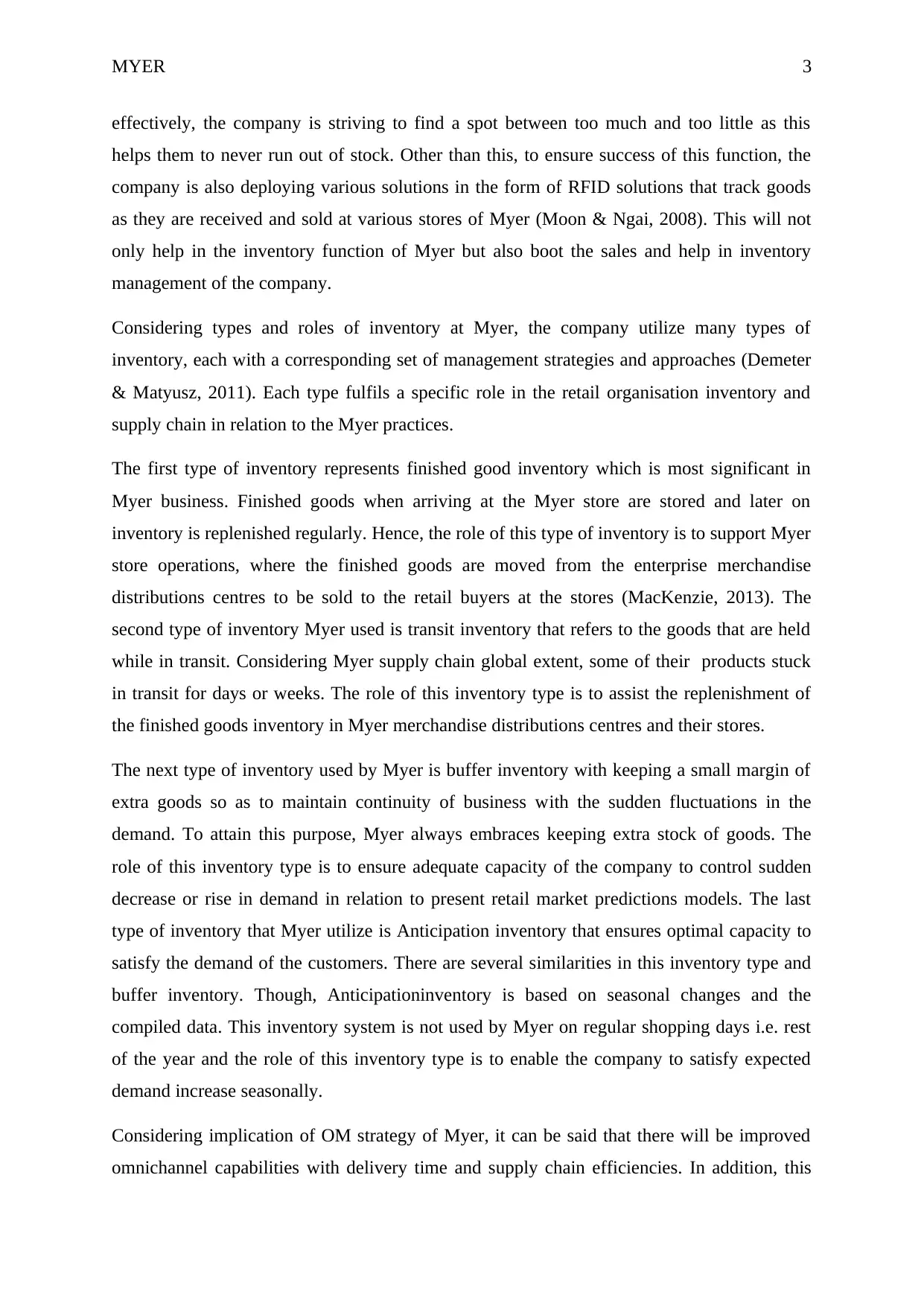
MYER 3
effectively, the company is striving to find a spot between too much and too little as this
helps them to never run out of stock. Other than this, to ensure success of this function, the
company is also deploying various solutions in the form of RFID solutions that track goods
as they are received and sold at various stores of Myer (Moon & Ngai, 2008). This will not
only help in the inventory function of Myer but also boot the sales and help in inventory
management of the company.
Considering types and roles of inventory at Myer, the company utilize many types of
inventory, each with a corresponding set of management strategies and approaches (Demeter
& Matyusz, 2011). Each type fulfils a specific role in the retail organisation inventory and
supply chain in relation to the Myer practices.
The first type of inventory represents finished good inventory which is most significant in
Myer business. Finished goods when arriving at the Myer store are stored and later on
inventory is replenished regularly. Hence, the role of this type of inventory is to support Myer
store operations, where the finished goods are moved from the enterprise merchandise
distributions centres to be sold to the retail buyers at the stores (MacKenzie, 2013). The
second type of inventory Myer used is transit inventory that refers to the goods that are held
while in transit. Considering Myer supply chain global extent, some of their products stuck
in transit for days or weeks. The role of this inventory type is to assist the replenishment of
the finished goods inventory in Myer merchandise distributions centres and their stores.
The next type of inventory used by Myer is buffer inventory with keeping a small margin of
extra goods so as to maintain continuity of business with the sudden fluctuations in the
demand. To attain this purpose, Myer always embraces keeping extra stock of goods. The
role of this inventory type is to ensure adequate capacity of the company to control sudden
decrease or rise in demand in relation to present retail market predictions models. The last
type of inventory that Myer utilize is Anticipation inventory that ensures optimal capacity to
satisfy the demand of the customers. There are several similarities in this inventory type and
buffer inventory. Though, Anticipationinventory is based on seasonal changes and the
compiled data. This inventory system is not used by Myer on regular shopping days i.e. rest
of the year and the role of this inventory type is to enable the company to satisfy expected
demand increase seasonally.
Considering implication of OM strategy of Myer, it can be said that there will be improved
omnichannel capabilities with delivery time and supply chain efficiencies. In addition, this
effectively, the company is striving to find a spot between too much and too little as this
helps them to never run out of stock. Other than this, to ensure success of this function, the
company is also deploying various solutions in the form of RFID solutions that track goods
as they are received and sold at various stores of Myer (Moon & Ngai, 2008). This will not
only help in the inventory function of Myer but also boot the sales and help in inventory
management of the company.
Considering types and roles of inventory at Myer, the company utilize many types of
inventory, each with a corresponding set of management strategies and approaches (Demeter
& Matyusz, 2011). Each type fulfils a specific role in the retail organisation inventory and
supply chain in relation to the Myer practices.
The first type of inventory represents finished good inventory which is most significant in
Myer business. Finished goods when arriving at the Myer store are stored and later on
inventory is replenished regularly. Hence, the role of this type of inventory is to support Myer
store operations, where the finished goods are moved from the enterprise merchandise
distributions centres to be sold to the retail buyers at the stores (MacKenzie, 2013). The
second type of inventory Myer used is transit inventory that refers to the goods that are held
while in transit. Considering Myer supply chain global extent, some of their products stuck
in transit for days or weeks. The role of this inventory type is to assist the replenishment of
the finished goods inventory in Myer merchandise distributions centres and their stores.
The next type of inventory used by Myer is buffer inventory with keeping a small margin of
extra goods so as to maintain continuity of business with the sudden fluctuations in the
demand. To attain this purpose, Myer always embraces keeping extra stock of goods. The
role of this inventory type is to ensure adequate capacity of the company to control sudden
decrease or rise in demand in relation to present retail market predictions models. The last
type of inventory that Myer utilize is Anticipation inventory that ensures optimal capacity to
satisfy the demand of the customers. There are several similarities in this inventory type and
buffer inventory. Though, Anticipationinventory is based on seasonal changes and the
compiled data. This inventory system is not used by Myer on regular shopping days i.e. rest
of the year and the role of this inventory type is to enable the company to satisfy expected
demand increase seasonally.
Considering implication of OM strategy of Myer, it can be said that there will be improved
omnichannel capabilities with delivery time and supply chain efficiencies. In addition, this
Paraphrase This Document
Need a fresh take? Get an instant paraphrase of this document with our AI Paraphraser
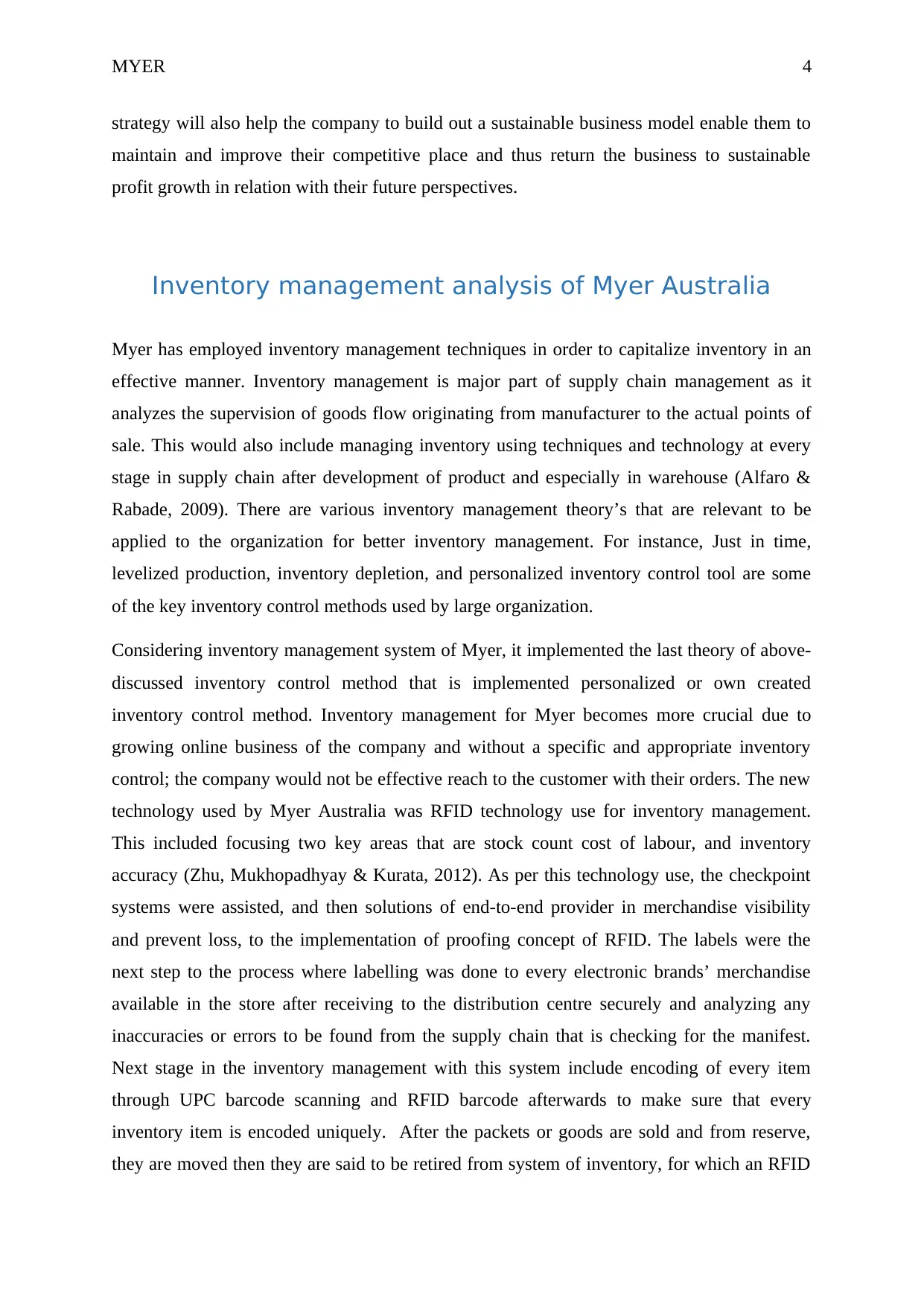
MYER 4
strategy will also help the company to build out a sustainable business model enable them to
maintain and improve their competitive place and thus return the business to sustainable
profit growth in relation with their future perspectives.
Inventory management analysis of Myer Australia
Myer has employed inventory management techniques in order to capitalize inventory in an
effective manner. Inventory management is major part of supply chain management as it
analyzes the supervision of goods flow originating from manufacturer to the actual points of
sale. This would also include managing inventory using techniques and technology at every
stage in supply chain after development of product and especially in warehouse (Alfaro &
Rabade, 2009). There are various inventory management theory’s that are relevant to be
applied to the organization for better inventory management. For instance, Just in time,
levelized production, inventory depletion, and personalized inventory control tool are some
of the key inventory control methods used by large organization.
Considering inventory management system of Myer, it implemented the last theory of above-
discussed inventory control method that is implemented personalized or own created
inventory control method. Inventory management for Myer becomes more crucial due to
growing online business of the company and without a specific and appropriate inventory
control; the company would not be effective reach to the customer with their orders. The new
technology used by Myer Australia was RFID technology use for inventory management.
This included focusing two key areas that are stock count cost of labour, and inventory
accuracy (Zhu, Mukhopadhyay & Kurata, 2012). As per this technology use, the checkpoint
systems were assisted, and then solutions of end-to-end provider in merchandise visibility
and prevent loss, to the implementation of proofing concept of RFID. The labels were the
next step to the process where labelling was done to every electronic brands’ merchandise
available in the store after receiving to the distribution centre securely and analyzing any
inaccuracies or errors to be found from the supply chain that is checking for the manifest.
Next stage in the inventory management with this system include encoding of every item
through UPC barcode scanning and RFID barcode afterwards to make sure that every
inventory item is encoded uniquely. After the packets or goods are sold and from reserve,
they are moved then they are said to be retired from system of inventory, for which an RFID
strategy will also help the company to build out a sustainable business model enable them to
maintain and improve their competitive place and thus return the business to sustainable
profit growth in relation with their future perspectives.
Inventory management analysis of Myer Australia
Myer has employed inventory management techniques in order to capitalize inventory in an
effective manner. Inventory management is major part of supply chain management as it
analyzes the supervision of goods flow originating from manufacturer to the actual points of
sale. This would also include managing inventory using techniques and technology at every
stage in supply chain after development of product and especially in warehouse (Alfaro &
Rabade, 2009). There are various inventory management theory’s that are relevant to be
applied to the organization for better inventory management. For instance, Just in time,
levelized production, inventory depletion, and personalized inventory control tool are some
of the key inventory control methods used by large organization.
Considering inventory management system of Myer, it implemented the last theory of above-
discussed inventory control method that is implemented personalized or own created
inventory control method. Inventory management for Myer becomes more crucial due to
growing online business of the company and without a specific and appropriate inventory
control; the company would not be effective reach to the customer with their orders. The new
technology used by Myer Australia was RFID technology use for inventory management.
This included focusing two key areas that are stock count cost of labour, and inventory
accuracy (Zhu, Mukhopadhyay & Kurata, 2012). As per this technology use, the checkpoint
systems were assisted, and then solutions of end-to-end provider in merchandise visibility
and prevent loss, to the implementation of proofing concept of RFID. The labels were the
next step to the process where labelling was done to every electronic brands’ merchandise
available in the store after receiving to the distribution centre securely and analyzing any
inaccuracies or errors to be found from the supply chain that is checking for the manifest.
Next stage in the inventory management with this system include encoding of every item
through UPC barcode scanning and RFID barcode afterwards to make sure that every
inventory item is encoded uniquely. After the packets or goods are sold and from reserve,
they are moved then they are said to be retired from system of inventory, for which an RFID
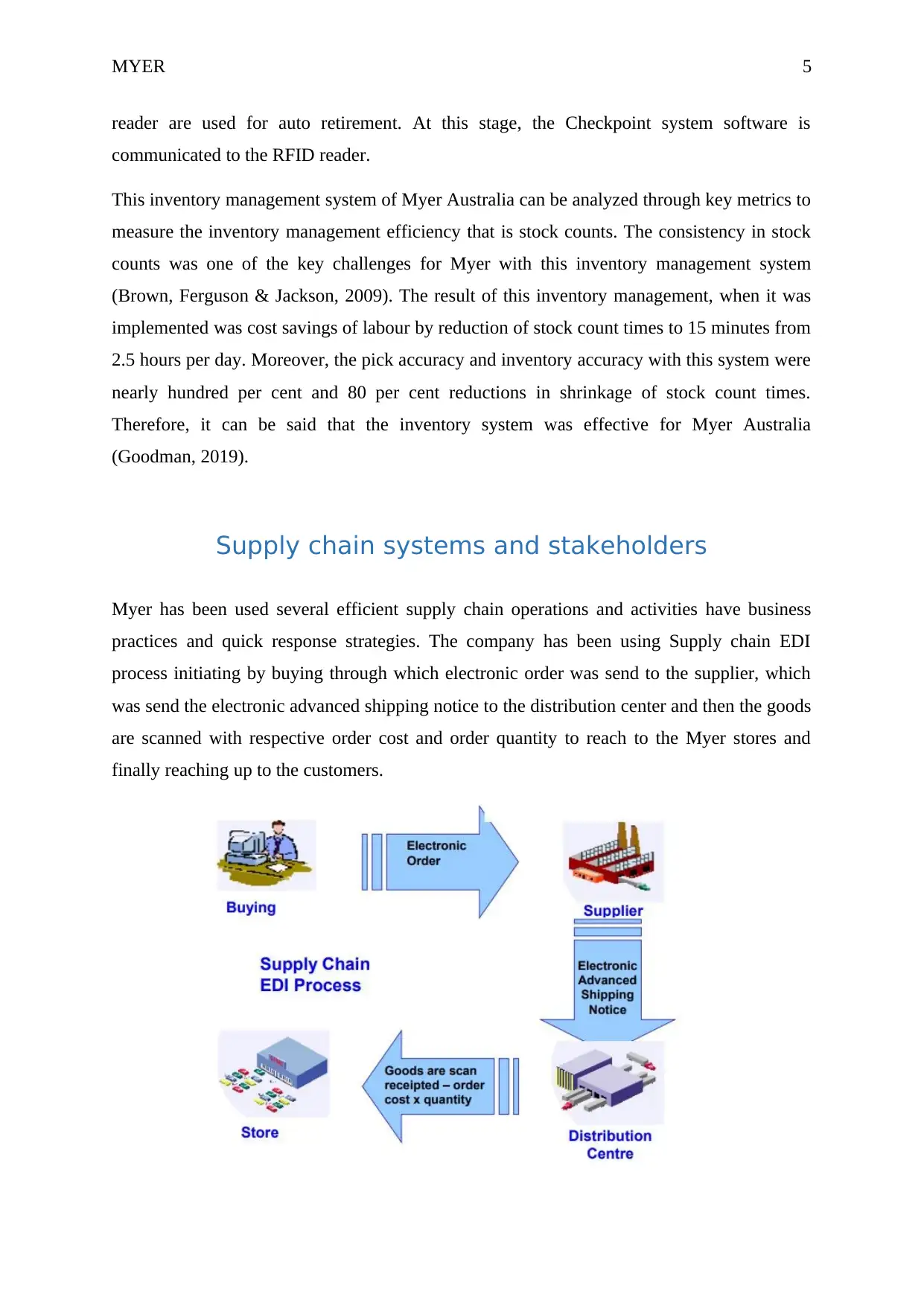
MYER 5
reader are used for auto retirement. At this stage, the Checkpoint system software is
communicated to the RFID reader.
This inventory management system of Myer Australia can be analyzed through key metrics to
measure the inventory management efficiency that is stock counts. The consistency in stock
counts was one of the key challenges for Myer with this inventory management system
(Brown, Ferguson & Jackson, 2009). The result of this inventory management, when it was
implemented was cost savings of labour by reduction of stock count times to 15 minutes from
2.5 hours per day. Moreover, the pick accuracy and inventory accuracy with this system were
nearly hundred per cent and 80 per cent reductions in shrinkage of stock count times.
Therefore, it can be said that the inventory system was effective for Myer Australia
(Goodman, 2019).
Supply chain systems and stakeholders
Myer has been used several efficient supply chain operations and activities have business
practices and quick response strategies. The company has been using Supply chain EDI
process initiating by buying through which electronic order was send to the supplier, which
was send the electronic advanced shipping notice to the distribution center and then the goods
are scanned with respective order cost and order quantity to reach to the Myer stores and
finally reaching up to the customers.
reader are used for auto retirement. At this stage, the Checkpoint system software is
communicated to the RFID reader.
This inventory management system of Myer Australia can be analyzed through key metrics to
measure the inventory management efficiency that is stock counts. The consistency in stock
counts was one of the key challenges for Myer with this inventory management system
(Brown, Ferguson & Jackson, 2009). The result of this inventory management, when it was
implemented was cost savings of labour by reduction of stock count times to 15 minutes from
2.5 hours per day. Moreover, the pick accuracy and inventory accuracy with this system were
nearly hundred per cent and 80 per cent reductions in shrinkage of stock count times.
Therefore, it can be said that the inventory system was effective for Myer Australia
(Goodman, 2019).
Supply chain systems and stakeholders
Myer has been used several efficient supply chain operations and activities have business
practices and quick response strategies. The company has been using Supply chain EDI
process initiating by buying through which electronic order was send to the supplier, which
was send the electronic advanced shipping notice to the distribution center and then the goods
are scanned with respective order cost and order quantity to reach to the Myer stores and
finally reaching up to the customers.
⊘ This is a preview!⊘
Do you want full access?
Subscribe today to unlock all pages.

Trusted by 1+ million students worldwide

MYER 6
Source: (myersupplier.myer.com.au, 2017)
Stakeholders play a major role in the supply chain process of the company as they have a
different level of influence on the company and level of interest also vary. The key external
stakeholders in the supply chain include suppliers, merchandiser, customers, and
intermediaries or distributors. Myer needs a supplier that is committed to closely working to
meet the customer needs, committed for service improvement and ongoing quality.
Moreover, the supplier of the Myer has to be committed in short cycle operations to develop
to fulfil the demands of the customer in the most cost-effective way. The key merchandising
activities include marketing, transportation, buying, distribution, replenishment, receiving,
performance measurement or administration management, handling stores and merchandise
presentation (Sen, 2008).
Every stakeholder associated with Myer Australia is influencing and affecting the
organization operations management. For instance, in order to ensure cost-effectiveness and
efficiency, the distribution strategies have been changed for satisfying customer to greater
extent, as online growing business of Myer has been responsible for which reach to the
customer. Moreover, with changing social trend, it has become important for the company to
provide one of two-day delivery for which the company had to re-engineer its supply chain
(Bhardwaj & Fairhurst, 2010). Moreover, another impact on organization was on
organization reporting structure and organizational roles that would be aligned to provide and
deliver business needs.
Moreover, the EDI process has been impacted to reach up to the operational standards set by
the company for supply chain considering the stakeholder's influence over the company.
Among all, the major influence is of customers, for which the EDI process consider key
performance areas to be cost effective for the company’s stakeholders that are to increase the
profit margin. Another area is customer service that is to increase customer satisfaction and
customer loyalty and deliver the needs of eth customers. Speed and data accuracy are other
KPA that would include the elimination of inconsistency and improved cycle times.
Moreover, the data accuracy is responsible for the elimination of cross-functional
inefficiencies, reduction of data errors and elimination of manual process that will be
influenced due to the internal key stakeholder of the company that is the employees of the
company.
Source: (myersupplier.myer.com.au, 2017)
Stakeholders play a major role in the supply chain process of the company as they have a
different level of influence on the company and level of interest also vary. The key external
stakeholders in the supply chain include suppliers, merchandiser, customers, and
intermediaries or distributors. Myer needs a supplier that is committed to closely working to
meet the customer needs, committed for service improvement and ongoing quality.
Moreover, the supplier of the Myer has to be committed in short cycle operations to develop
to fulfil the demands of the customer in the most cost-effective way. The key merchandising
activities include marketing, transportation, buying, distribution, replenishment, receiving,
performance measurement or administration management, handling stores and merchandise
presentation (Sen, 2008).
Every stakeholder associated with Myer Australia is influencing and affecting the
organization operations management. For instance, in order to ensure cost-effectiveness and
efficiency, the distribution strategies have been changed for satisfying customer to greater
extent, as online growing business of Myer has been responsible for which reach to the
customer. Moreover, with changing social trend, it has become important for the company to
provide one of two-day delivery for which the company had to re-engineer its supply chain
(Bhardwaj & Fairhurst, 2010). Moreover, another impact on organization was on
organization reporting structure and organizational roles that would be aligned to provide and
deliver business needs.
Moreover, the EDI process has been impacted to reach up to the operational standards set by
the company for supply chain considering the stakeholder's influence over the company.
Among all, the major influence is of customers, for which the EDI process consider key
performance areas to be cost effective for the company’s stakeholders that are to increase the
profit margin. Another area is customer service that is to increase customer satisfaction and
customer loyalty and deliver the needs of eth customers. Speed and data accuracy are other
KPA that would include the elimination of inconsistency and improved cycle times.
Moreover, the data accuracy is responsible for the elimination of cross-functional
inefficiencies, reduction of data errors and elimination of manual process that will be
influenced due to the internal key stakeholder of the company that is the employees of the
company.
Paraphrase This Document
Need a fresh take? Get an instant paraphrase of this document with our AI Paraphraser

MYER 7
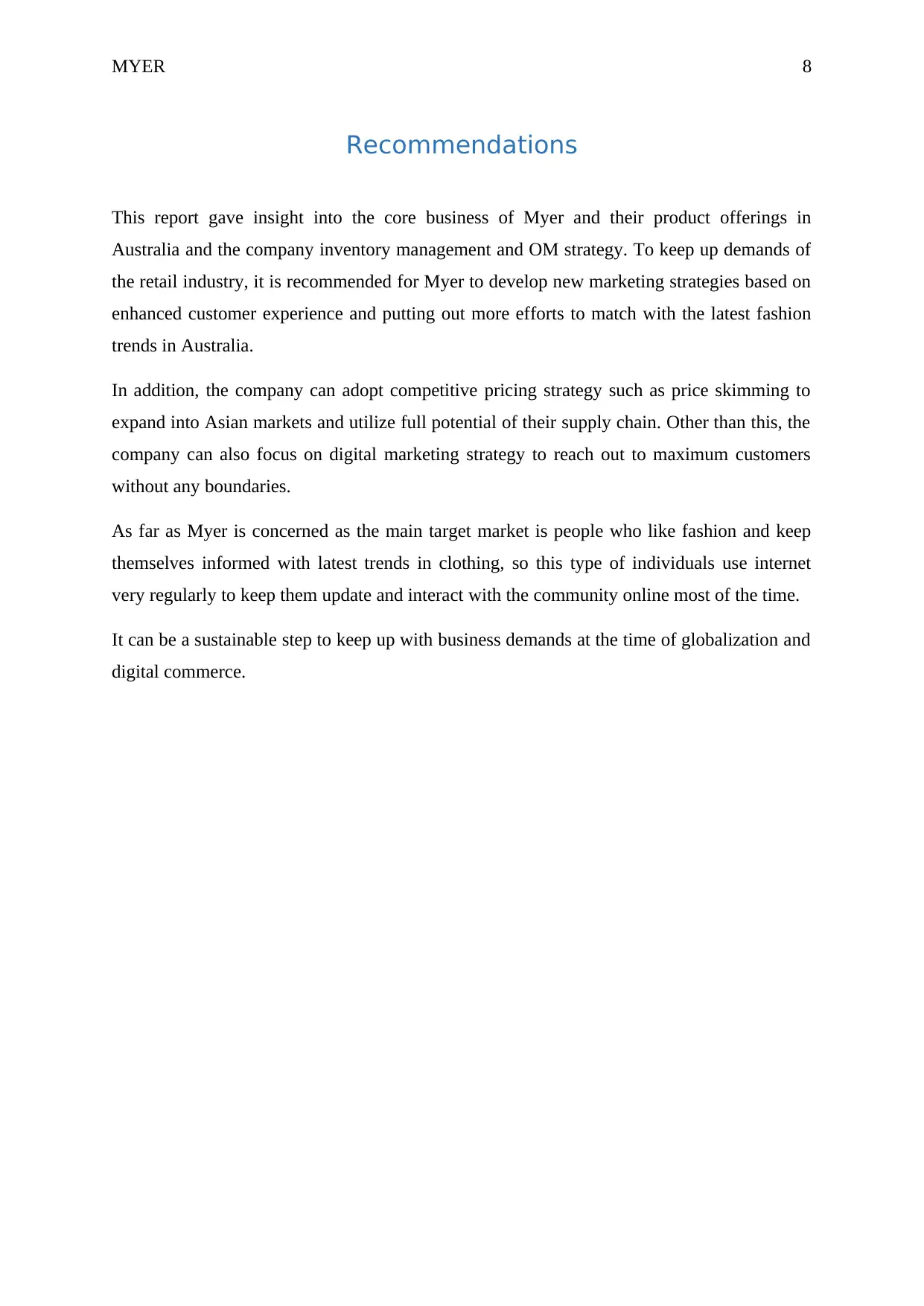
MYER 8
Recommendations
This report gave insight into the core business of Myer and their product offerings in
Australia and the company inventory management and OM strategy. To keep up demands of
the retail industry, it is recommended for Myer to develop new marketing strategies based on
enhanced customer experience and putting out more efforts to match with the latest fashion
trends in Australia.
In addition, the company can adopt competitive pricing strategy such as price skimming to
expand into Asian markets and utilize full potential of their supply chain. Other than this, the
company can also focus on digital marketing strategy to reach out to maximum customers
without any boundaries.
As far as Myer is concerned as the main target market is people who like fashion and keep
themselves informed with latest trends in clothing, so this type of individuals use internet
very regularly to keep them update and interact with the community online most of the time.
It can be a sustainable step to keep up with business demands at the time of globalization and
digital commerce.
Recommendations
This report gave insight into the core business of Myer and their product offerings in
Australia and the company inventory management and OM strategy. To keep up demands of
the retail industry, it is recommended for Myer to develop new marketing strategies based on
enhanced customer experience and putting out more efforts to match with the latest fashion
trends in Australia.
In addition, the company can adopt competitive pricing strategy such as price skimming to
expand into Asian markets and utilize full potential of their supply chain. Other than this, the
company can also focus on digital marketing strategy to reach out to maximum customers
without any boundaries.
As far as Myer is concerned as the main target market is people who like fashion and keep
themselves informed with latest trends in clothing, so this type of individuals use internet
very regularly to keep them update and interact with the community online most of the time.
It can be a sustainable step to keep up with business demands at the time of globalization and
digital commerce.
⊘ This is a preview!⊘
Do you want full access?
Subscribe today to unlock all pages.

Trusted by 1+ million students worldwide
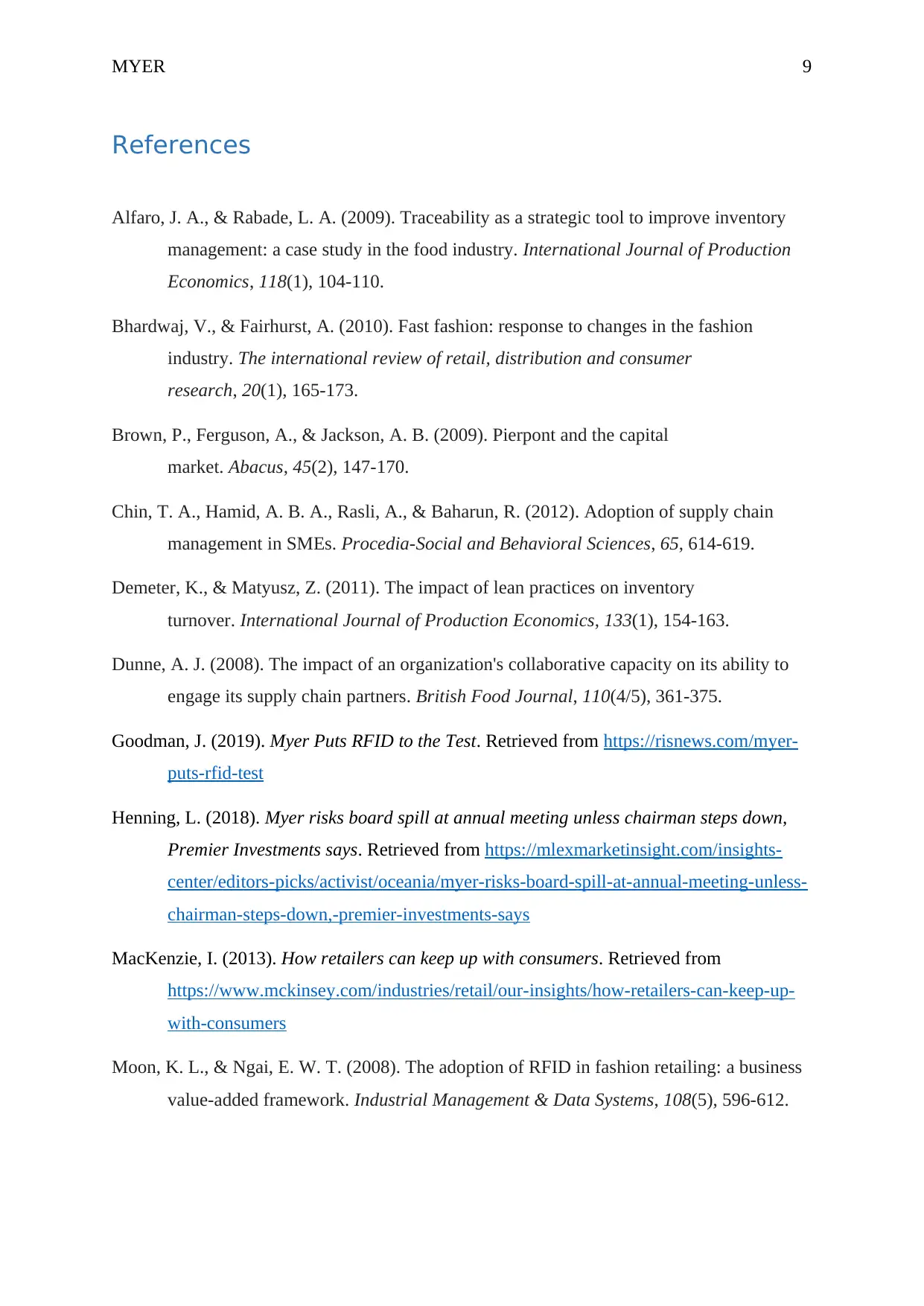
MYER 9
References
Alfaro, J. A., & Rabade, L. A. (2009). Traceability as a strategic tool to improve inventory
management: a case study in the food industry. International Journal of Production
Economics, 118(1), 104-110.
Bhardwaj, V., & Fairhurst, A. (2010). Fast fashion: response to changes in the fashion
industry. The international review of retail, distribution and consumer
research, 20(1), 165-173.
Brown, P., Ferguson, A., & Jackson, A. B. (2009). Pierpont and the capital
market. Abacus, 45(2), 147-170.
Chin, T. A., Hamid, A. B. A., Rasli, A., & Baharun, R. (2012). Adoption of supply chain
management in SMEs. Procedia-Social and Behavioral Sciences, 65, 614-619.
Demeter, K., & Matyusz, Z. (2011). The impact of lean practices on inventory
turnover. International Journal of Production Economics, 133(1), 154-163.
Dunne, A. J. (2008). The impact of an organization's collaborative capacity on its ability to
engage its supply chain partners. British Food Journal, 110(4/5), 361-375.
Goodman, J. (2019). Myer Puts RFID to the Test. Retrieved from https://risnews.com/myer-
puts-rfid-test
Henning, L. (2018). Myer risks board spill at annual meeting unless chairman steps down,
Premier Investments says. Retrieved from https://mlexmarketinsight.com/insights-
center/editors-picks/activist/oceania/myer-risks-board-spill-at-annual-meeting-unless-
chairman-steps-down,-premier-investments-says
MacKenzie, I. (2013). How retailers can keep up with consumers. Retrieved from
https://www.mckinsey.com/industries/retail/our-insights/how-retailers-can-keep-up-
with-consumers
Moon, K. L., & Ngai, E. W. T. (2008). The adoption of RFID in fashion retailing: a business
value-added framework. Industrial Management & Data Systems, 108(5), 596-612.
References
Alfaro, J. A., & Rabade, L. A. (2009). Traceability as a strategic tool to improve inventory
management: a case study in the food industry. International Journal of Production
Economics, 118(1), 104-110.
Bhardwaj, V., & Fairhurst, A. (2010). Fast fashion: response to changes in the fashion
industry. The international review of retail, distribution and consumer
research, 20(1), 165-173.
Brown, P., Ferguson, A., & Jackson, A. B. (2009). Pierpont and the capital
market. Abacus, 45(2), 147-170.
Chin, T. A., Hamid, A. B. A., Rasli, A., & Baharun, R. (2012). Adoption of supply chain
management in SMEs. Procedia-Social and Behavioral Sciences, 65, 614-619.
Demeter, K., & Matyusz, Z. (2011). The impact of lean practices on inventory
turnover. International Journal of Production Economics, 133(1), 154-163.
Dunne, A. J. (2008). The impact of an organization's collaborative capacity on its ability to
engage its supply chain partners. British Food Journal, 110(4/5), 361-375.
Goodman, J. (2019). Myer Puts RFID to the Test. Retrieved from https://risnews.com/myer-
puts-rfid-test
Henning, L. (2018). Myer risks board spill at annual meeting unless chairman steps down,
Premier Investments says. Retrieved from https://mlexmarketinsight.com/insights-
center/editors-picks/activist/oceania/myer-risks-board-spill-at-annual-meeting-unless-
chairman-steps-down,-premier-investments-says
MacKenzie, I. (2013). How retailers can keep up with consumers. Retrieved from
https://www.mckinsey.com/industries/retail/our-insights/how-retailers-can-keep-up-
with-consumers
Moon, K. L., & Ngai, E. W. T. (2008). The adoption of RFID in fashion retailing: a business
value-added framework. Industrial Management & Data Systems, 108(5), 596-612.
Paraphrase This Document
Need a fresh take? Get an instant paraphrase of this document with our AI Paraphraser
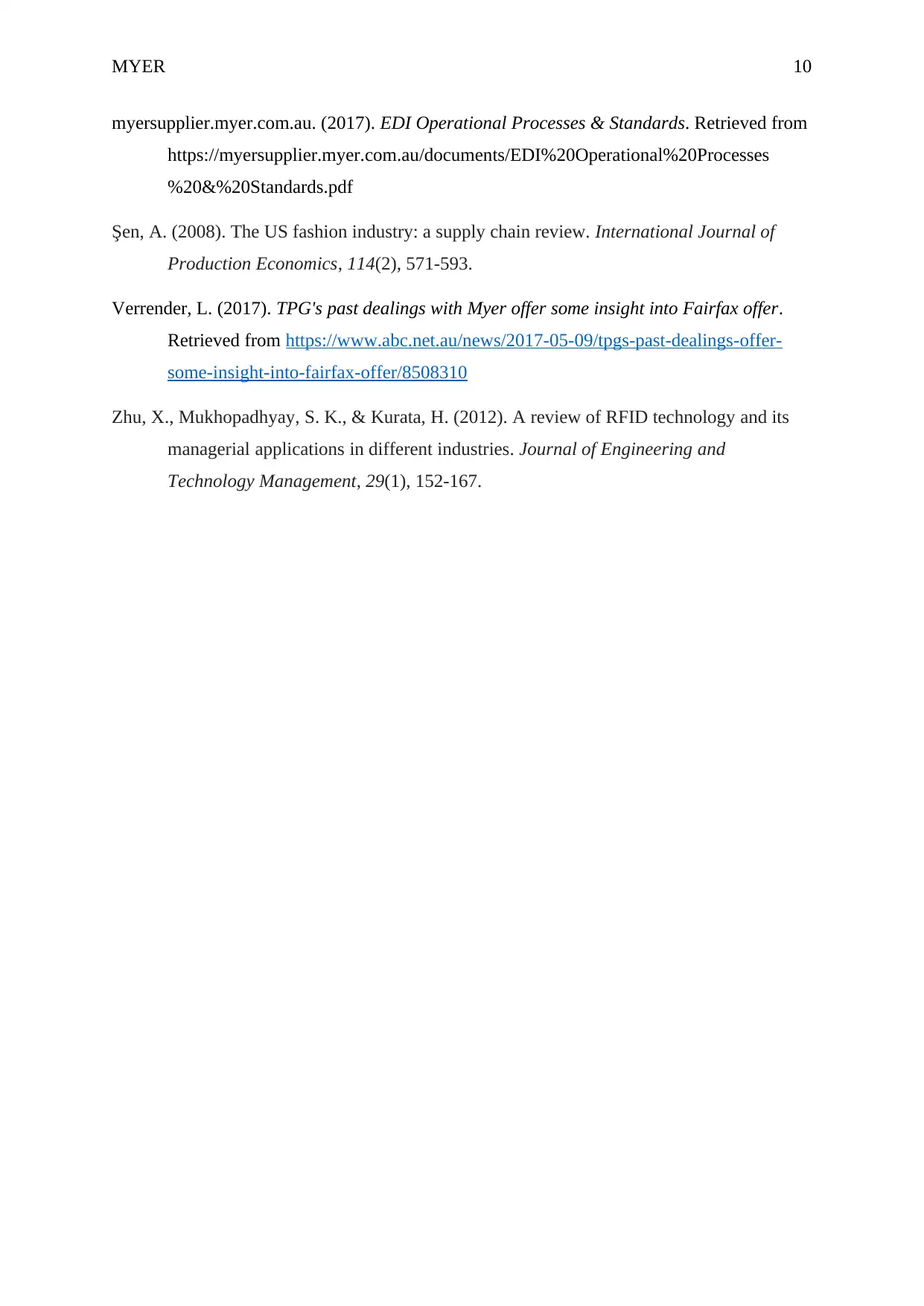
MYER 10
myersupplier.myer.com.au. (2017). EDI Operational Processes & Standards. Retrieved from
https://myersupplier.myer.com.au/documents/EDI%20Operational%20Processes
%20&%20Standards.pdf
Şen, A. (2008). The US fashion industry: a supply chain review. International Journal of
Production Economics, 114(2), 571-593.
Verrender, L. (2017). TPG's past dealings with Myer offer some insight into Fairfax offer.
Retrieved from https://www.abc.net.au/news/2017-05-09/tpgs-past-dealings-offer-
some-insight-into-fairfax-offer/8508310
Zhu, X., Mukhopadhyay, S. K., & Kurata, H. (2012). A review of RFID technology and its
managerial applications in different industries. Journal of Engineering and
Technology Management, 29(1), 152-167.
myersupplier.myer.com.au. (2017). EDI Operational Processes & Standards. Retrieved from
https://myersupplier.myer.com.au/documents/EDI%20Operational%20Processes
%20&%20Standards.pdf
Şen, A. (2008). The US fashion industry: a supply chain review. International Journal of
Production Economics, 114(2), 571-593.
Verrender, L. (2017). TPG's past dealings with Myer offer some insight into Fairfax offer.
Retrieved from https://www.abc.net.au/news/2017-05-09/tpgs-past-dealings-offer-
some-insight-into-fairfax-offer/8508310
Zhu, X., Mukhopadhyay, S. K., & Kurata, H. (2012). A review of RFID technology and its
managerial applications in different industries. Journal of Engineering and
Technology Management, 29(1), 152-167.
1 out of 11
Related Documents
Your All-in-One AI-Powered Toolkit for Academic Success.
+13062052269
info@desklib.com
Available 24*7 on WhatsApp / Email
![[object Object]](/_next/static/media/star-bottom.7253800d.svg)
Unlock your academic potential
Copyright © 2020–2025 A2Z Services. All Rights Reserved. Developed and managed by ZUCOL.





